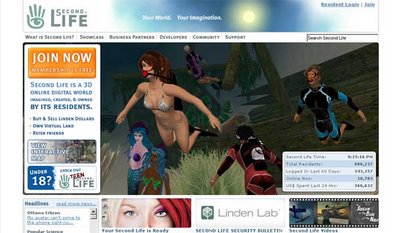
Second Life is a 3-D virtual world entirely built and owned by its residents. Since opening to the public in 2003, it has grown explosively and today is inhabited by 343,157 people from around the globe.
Second Life (SL) is a privately-owned, partly subscription-based 3-D virtual world, made publicly available in 2003 by San Francisco-based Linden Lab, and founded by former RealNetworks CTO Philip Rosedale. The Second Life "world" resides in a large array of servers that are owned and maintained by Linden Lab, known collectively as "the grid". The Second Life client program provides its users (referred to as Residents) with tools to view and modify the SL world and participate in its virtual economy, which concurrently has begun to operate as a "real" market. As of September 2006, Second Life has approximately 740,000 total user accounts and 318,000 users active over the previous 60 days.
Second Life is available for PCs with around 800 MHz Pentium III or better, with at least 256MB RAM with Windows XP (SP2) or Windows 2000 (SP4) and Macs (1 GHz G4 or better, with at least 512MB RAM) with Mac OS X 10.3.9 or higher. A Linux alpha client (i686) that has been tested on Debian, Fedora Core 4, Gentoo and Knoppix is currently available for download and testing, and runs with a few limitations.
The graphics require either an nVidia GeForce 2 or better graphics card or an ATI Radeon 8500 (9000 for Macs) graphics card. Second Life also requires a 25MB (Windows) or 50MB (Mac OS X) client download, and will consume between 50MB and 1GB of allocated disk space for cache. A broadband Internet connection is required. Dial-up users will find that their connection speed does not allow for them to download and view the world at an acceptable rate. Current system requirements are posted at the web site
Second Life has three membership plans.
First Basic - Free
Additional Basic - Additional Basic accounts are available for a one time fee of $9.95 per additional account
Premium - The only differences between these accounts and First Basic accounts (aside from the fee) are the ability to own land (Basic account holders can rent), a L$400/week Stipend and a L$1000 signup bonus. There are three billing options for Premium accounts:
Monthly — $9.95
Quarterly — $22.50 ($7.50/month)
Annually — $72.00 ($6.00/month)
Basic accounts originally received L$250 starting money and a stipend of L$50 a week for every week users were logged in. However, basic accounts created after May 29, 2006 no longer receive the L$50/week stipend, and basic accounts created after June 6, 2006 no longer receive starting money without confirmation of credit card or other valid identity information. However, Basic accounts originally required billing information to be presented (even though no charge was made) because of the need to prevent people creating multiple basic accounts in order to benefit from the stipend multiple times; now that this has been removed, Basic accounts can be created with only an e-mail address, which at last report was not even verified.
Second Life has its own economy and a currency referred to as Linden Dollars (L$). Residents receive an amount of L$ when they open an account, and a weekly stipend thereafter — the amount depends on the type of account. Additional L$s are acquired by selling objects or services within the environment. Residents may purchase L$ directly or convert between Linden currency and U.S. currency through either Linden Lab's currency brokerage, the LindeX Currency Exchange, or other third-party currency exchanges. The ratio of USD to L$ fluctuates daily as Residents set the buy and sell price of L$ offered on the exchange, and it has fluctated between 240 L$/USD and 350 L$/USD over the past 12 months (October, 2005 to September 2006). As a point of reference, the current lowest yearly membership fee in Second Life is $72 USD. A premium user, who receives a 400 L$/week stipened that never bought or sold in Second Life (or who bought and sold in equal amounts) would accumulate 20,800 L$/year. Selling this amount on a currency exchange (negating exchange fees) would result in the user receiving back the $72 USD membership fee if they were able to obtain an exchange rate of 290 L$/USD. As of September 14, 2006, the best exchange rate for selling currency was 298 L$/USD.
Linden Lab has stated that the Second Life economy generated US$3,596,674 in economic activity during the month of September 2005. According to a September 2006 Popular Science article, Second Life, through currency trading, shopping and land sales, has a GDP of $64 Million.
via: Wikipedia
![Ulamonge blog - [street art, design, art, pop culture, news, life]](https://blogger.googleusercontent.com/img/b/R29vZ2xl/AVvXsEhQq95iTPd8YTa-0hWO_EcIrB7Eg2hrmNBmYVfe1r6k4fDgLBwEGiVFrmAbjeZEi-irmItCoRQel2F7t_yhji2gSys6mhI8dELD6DYsedLbxWdl28ANWcNljBGByBlrPHMC4ZLP/s1600/ulamonge_blog_200_75.jpg)
![Ulamonge blog - [street art, design, art, pop culture, news, life]](https://blogger.googleusercontent.com/img/b/R29vZ2xl/AVvXsEgkbmBbbTaqu1NpOxwyLZseB9zrwJtXAbGZyqbZuf0HdgLri2v0lX8Zk_dswAfhSvK-l8_ltzxZd1KqlXSjEX-dzMNoA82sphO7RUsddCJfrk5vds-MThBNtZ_7VtNRW_4L15-a/s1600/ulamonge_blog_200_75.jpg)
 Vintage USA Star Symbol T-Shirt
Vintage USA Star Symbol T-Shirt Bring Vinyl Back Pillow
Bring Vinyl Back Pillow "Libertad" ["Freedom" in Spanish] T-Shirt
"Libertad" ["Freedom" in Spanish] T-Shirt




0 Comments